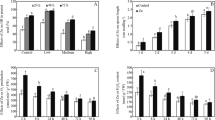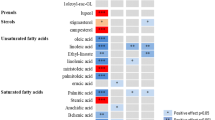Abstract
Non-protein amino acid 4-hydroxyisoleucine (4HIL) from Trigonella persica Boiss., the only endemic species in Iran from the Fabaceae family, is known for its anti-diabetic property. 4HIL content was evaluated by HPTLC (High-performance thin-layer chromatography) method in seedlings (every 24 h for 6 days), 21-day plantlets, and 42-day mature plants growing from seeds treated with 5 and 7.5 mM isoleucine (Ile) compared to those growing from untreated seeds. The content of 4HIL showed an increasing trend during germination as it reached the highest level of 717 µg 100 mg − 1 FW on day 5 at 7.5 mM. The Ile significantly increased the growth parameters and anatomical properties of T. persica. Besides, Ile increased the carbohydrate content and the membrane stability of T. persica. Histochemical tests were also accomplished as evidenced by the maximum presence of starch on day 3, and lipids on day 5 in the mesophyll of cotyledons. In this research, the seedlings of T. persica. growing from treated seeds with 7.5 mM Ile were found to be a promising source of 4HIL on day 5 after imbibition.











Similar content being viewed by others
References
Abou Dahab TAM, Abd El-Aziz NG (2006) Physiological effect of diphenylamin and tryptophan on the growth and chemical constituents of Philodendron erubescens plants. World J Agric Sci 2:75–81
Azza SM, Yousef RS (2015) Response of basil plant (Ocimum sanctum L.) to foliar spray with amino acids or seaweed extract. J Hortic Sci Ornam Plants 7:94–106. DOI:https://doi.org/10.5829/idosi.jhsop.2015.7.3.1161
Bakhshy E, Zarinkamar F, Nazari M (2019) Isolation, qualitative and quantitative evaluation of galactomanan during germination of Trigonella persica (Fabaceae) seed. Inter J Biol Macromol 137:286–295. DOI:https://doi.org/10.1016/j.ijbiomac.2019.06.225
Betty R (2008) The many healing virtues of fenugreek.Spice India, p.17–19
Bell EA (2003) Nonprotein amino acids of plants: significance in medicine, nutrition, and agriculture. J Agricul Food Chem 51:2854–2865. DOI:https://doi.org/10.1021/jf020880w
Broca C, Manteghetti M, Gross R, Baissac Y, Jacob M, Petit P, Sauvaire Y, Ribes G (2000) 4-Hydroxyisoleucine: effects of synthetic and natural analogues on insulin secretion. Eur J Pharmacol 390:339–345. DOI:https://doi.org/10.1016/s0014-2999(00)00030-3
Compton RH (1912) An investigation of the seedling structure in the Leguminosae. Bot J Linn Soc 41:1–122
El-Desouky SA, Ismaeil FH, Wanas AL, Fathy ESL, Abd El-All MM (2011) Effect of yeast extract, amino acids and citric acid on physioanatomical aspects and productivity of tomato plants grown in late summer season. Minufiya J Agric Res 36:859–884
El-Aal FSA, Shaheen AM, Ahmed AA, Mahmoud AR (2010) Effect of foliar application of urea and amino acids mixtures as antioxidants on growth, yield and characteristics of squash. Res J Agricul Biol Sci 6:583–588
Ghadiri S, Jafari A, Hamdi MM (2014) Comparative morphological, anatomical and palynological studies on Trigonella (Fabaceae) in Khorassan Razavi province (NE Iran). Bangladesh J Bot 43:123–129
Gopu CL, Gilda SS, Paradkar AR, Mahadik KR (2008) Development and validation of a densitometric TLC method for analysis of trigonelline and 4-hydroxyisoleucine in fenugreek seeds. Acta Chromatogr 20:709–719. https://doi.org/10.1556/achrom.20.2008.4.15
Ge T, Song S, Roberts P, Jones DL, Huang D, Iwasaki K (2009) Amino acids as a nitrogen source for tomato seedlings: the use of dual-labeled (13 C, 15 N) glycine to test for direct uptake by tomato seedlings. Environ Exper Bot 66:357–361. https://doi.org/10.1016/j.envexpbot.2009.05.004
Harris WM (1987) Comparative Ultrastructure of Developing Seed Coats of” Hard-Seeded” and” Soft-Seeded” Varieties of Soybean, Glycine max (L.) Merr. Bot Gaz 148:324–331. https://doi.org/10.1086/337660
Hansen J, Moller IB (1975) Percolation of starch and soluble carbohydrates from plant tissue for quantitative determination with anthrone. Anal Biochem 68:87–94. DOI:https://doi.org/10.1016/0003-2697(75)90682-x
Hajimehdipoor H, Sadat-Ebrahimi SE, Amanzadeh Y, Izaddoost M, Givi E (2010) Identification and Quantitative Determination of 4-Hydroxyisoleucine in Trigonella foenum-graecum L. from Iran. J Med Plants 9:29–34
Heath RL, Packer L (1968) Photoperoxidation in isolated chloroplasts: I. Kinetics and stoichiometry of fatty acid peroxidation. Arch Biochem Biophys 125:189–198. DOI:https://doi.org/10.1016/0003-9861(68)90654-1
Hillaire-Buys D, Petit P, Manteghetti M, Baissac Y, Sauvaire Y, Ribes G (1993) A recently identified substance extracted from fenugreek seeds stimulates insulin secretion in rat. Diabetologia 36:A119
Jensen WA (1962) Botanical histochemistry: principles and practice. W H Freeman, San Francisco
Johansen DA (1940) Plant microtechique. McGraw-Hill Book Company, Inc, London
Joshi V, Jander G (2009) Arabidopsis methionine gamma-lyase is regulated according to isoleucine biosynthesis needs but plays a subordinate role to threonine deaminase. Plant Physiol 151:367–378. https://doi.org/10.1104/pp.109.138651
Kochhar A, Nagi M, Sachdeva R (2006) Proximate composition, available carbohydrates, dietary fibre and anti-nutritional factors of selected traditional medicinal plants. J Hum Ecol 19:195–199. https://doi.org/10.1080/09709274.2006.11905878
Khandani S, Assadi M, Nejadsatari T, Mehregan I (2016) Phenetic analysis of the genera medicagoid Trigonella, Medicago and Melilotus (Fabaceae) on seed coat in Iran. Biodivers 17:162–171. DOI:https://doi.org/10.13057/biodiv/d170124
Kodera T, Smirnov SV, Samsonova NN, Kozlov YI, Koyama R, Hibi M et al (2009) A novel L-isoleucine hydroxylating enzyme, L-isoleucine dioxygenase from Bacillus thuringiensis, produces (2S, 3R, 4S)-4-hydroxyisoleucine. Biochem Biophys Res Commun 390:506–510. DOI:https://doi.org/10.1016/j.bbrc.2009.09.126
Marhoon IA, Abbas MK (2015) Effect of foliar application of seaweed extract and amino acids on some vegetative and anatomical characters of two sweet pepper (Capsicum Annuum L.) cultivars. Inter J Res Stud Agric Sci 1:35–44
Metcalf CR, Chalk L (1957) Anatomy of the Dicotyledones. Oxford at the clarendon press
Miersch O, Weichert H, Stenzel I, Hause B, Maucher H, Feussner I, Wasternack C (2004) Constitutive overexpression of allene oxide cyclase in tomato (Lycopersicon esculentum cv. Lukullus) elevates levels of some jasmonates and octadecanoids in flower organs but not in leaves. Phytochem 65:847–856. DOI:https://doi.org/10.1016/j.phytochem.2004.01.016
Miraldi E, Ferri S, Mostaghimi V (2001) Botanical drugs and preparations in the traditional medicine of West Azerbaijan (Iran). J Ethnopharmacol 75:77–87. DOI:https://doi.org/10.1016/s0378-8741(00)00381-0
Murata T, Sugiyama T, Akazawa T (1964) Enzymic mechanism of starch synthesis in ripening rice grains: II. Adenosine diphosphate glucose pathway. Arch Biochem Biophys 107:92–101. DOI:https://doi.org/10.1016/0003-9861(64)90274-7
Nour AAM, Magboul BI (1986) Chemical and amino acid composition of fenugreek seeds grown in Sudan. Food Chem 22:1–5. DOI:https://doi.org/10.1016/0308-8146(86)90002-6
Parker AJ, Haskins EF, Deyrup-Olsen I (1982) Toluidine blue: a simple, effective stain for plant tissues. Am Biol Teach 44:487–489
Petropoulos GA (2002) Fenugreek-The genus Trigonella-Taylor and Francis. London and New York, 200
Petit P, Sauvaire Y, Hillaire-Buys D, Manteghetti M, Baissac Y, Gross R, Ribes G (1995) Insulin stimulating effect of 4-hydroxyisoleucine purified from fenugreek seeds. In: Abstracts, Seminar of the French Association of Pharmacology. Lariboisiere, Paris, 23–24 March, Fundam Clin Pharmacol 9:395–408
Raeisi M, Farahani L, Palashi M (2014) Changes of qualitative and quantitative properties of radish (Raphanus sativus L.) under foliar spraying through amino acid. Interl J Biosci 4:463–468. https://doi.org/10.12692/ijb/4.1.463-468
Ranjbar M, Hajmoradi Z, Karamian R (2010) The taxonomic importance of leaf epidermis morphology and peduncle anatomy in Trigonella disperma Bornm. ex Vassilcz. University of Isfahan. DOI:20.1001.1.20088906.1389.2.2.3.2
Ranjbar M, Hajmoradi Z (2012) Notes on Medicago sect. Lunatae Boiss. and Trigonella sect. Bucerates Boiss. of the tribe Trifolieae (Fabaceae), with two new records from Iran. Iran J Bot 18:235–238
Ranjbar M, Hajmoradi Z, Karamian R (2014) A new variety of Trigonella persica (Fabaceae) from Iran. Taxon Biosyst 21:83–86
Ranjbar M, Hajmoradi Z (2015) A new species ofTrigonellasect.Ellipticae(Leguminosae-Papilionoideae) from Iran, including cytogenetic and anatomical notes. Phytotaxa 202:26–34. https://doi.org/10.11646/phytotaxa.202.1.3. )
Ranjbar M, Hajmoradi Z (2016) Comparative leaf epidermis and anatomical study in populations of Trigonella spruneriana (Fabaceae) from Iran. Webbia 71:107–115. https://doi.org/10.1080/00837792.2016.1138673
Reid JS (1971) Reverse carbohydrate metabolism in germinating seeds of Trigonella foenum-graecum L. (Leguminosae). Planta 100:131–142. DOI:https://doi.org/10.1007/BF00385214
Reid JSG, Meier H (1972) The function of the aleurone layer during galactomannan mobilisation in germinating seeds of fenugreek (Trigonella foenum-graecum L.), crimson clover (Trifolium incarnatum L.) and lucerne (Medicago sativa L.): a correlative biochemical and ultrastructural study. Planta 106:44–60. DOI:https://doi.org/10.1007/BF00385472
Reid JG, Bewley JD (1979) A dual role for the endosperm and its galactomannan reserves in the germinative physiology of fenugreek (Trigonella foenum-graecum L.), an endospermic leguminous seed. Planta 147(2):145–150. DOI:https://doi.org/10.1007/BF00389515
Souza FH, Marcos-Filho JÚLIO (2001) The seed coat as a modulator of seed-environment relationships in Fabaceae. Braz J Bot 24(4):365–375. https://doi.org/10.1590/S0100-84042001000400002
Staswick PE, Tiryaki I (2004) The oxylipin signal jasmonic acid is activated by an enzyme that conjugates it to isoleucine in Arabidopsis. Plant Cell 16:2117–2127. https://doi.org/10.1105/tpc.104.023549
Stevenson TM (1937) Sweet clover studies on habit of growth, seed pigmentation and permeability of the seed coat. Sci Agric 17:627–654. https://doi.org/10.4141/sa-1937-0054
Swanson BG, Hughes JS, Rasmussen HP (1985) Seed microstructure: review of water imbibition in legumes. Food Struct 4:14
Sun J, Xu Y, Ye S, Jiang H, Chen Q, Li C (2009) Arabidopsis ASA1 is important for jasmonate-mediated regulation of auxin biosynthesis and transport during lateral root formation. Plant Cell 21:1495–1511. https://doi.org/10.1105/tpc.108.064303
Srivastava G, Kayastha AM (2014) β-Amylase from starchless seeds of Trigonella foenum-graecum and its localization in germinating seed. PLoS ONE 9:e88697. DOI:https://doi.org/10.1371/journal.pone.0088697
Shehata SM, Abdel-Azem HS, El-Yazied AA, El-Gizawy AM (2011) Effect of foliar spraying with amino acids and seaweed extract on growth chemical constitutes, yield and its quality of celeriac plant. Eur J Sci Res 58:257–265
Trelease RN, Doman DC (2013) Mobilization of oil and wax reserves. Seed Physiol 2:201–245. https://doi.org/10.1016/B978-0-12-511902-3.50011-7
Thines B, Katsir L, Melotto M, Niu Y, Mandaokar A, Liu G et al (2007) JAZ repressor proteins are targets of the SCFCOI1 complex during jasmonate signaling. Nature 448:661–665. DOI:https://doi.org/10.1038/nature05960
Wareing PF, Phillips IDJ (1970) The control of growth and differentiation in plants. Pergamon Press, Oxford
Yu H, Zhang F, Wang G, Liu D (2012) Partial deficiency of isoleucine impairs root development and alters transcript levels of the genes involved in branched-chain amino acid and glucosinolate metabolism in Arabidopsis. J Exper Bot 64:599–612. DOI:https://doi.org/10.1093/jxb/ers352
Zhang Y, Zhang K, Ji Y, Tao J (2020) Physical dormancy and soil seed bank dynamics in seeds of Melilotus albus (Fabaceae). Flora 266:151600. DOI:https://doi.org/10.1016/j.flora.2020.151600
Acknowledgements
This research has been supported by Tarbiat Modares University (Student Research Program).
Author information
Authors and Affiliations
Contributions
AM and NMB have contributed to the major bench experiments. FZ designed the experiments and supervised the entire work and drafted the manuscript and critically revised the final version. MR helped in the writing of manuscript and critical revision of the final manuscript.
Corresponding author
Ethics declarations
Conflict of interest
No potential conflict of interest was reported by the authors.
Additional information
Publisher’s Note
Springer Nature remains neutral with regard to jurisdictional claims in published maps and institutional affiliations.
Electronic supplementary material
Below is the link to the electronic supplementary material.
Rights and permissions
About this article
Cite this article
Zarinkamar, F., Moradi, A., MohamadBagheri, N. et al. Isoleucine treatment of seeds increased the content of 4-hydroxyisoleucine and affected the anatomy properties of Trigonella persica Boiss. At different developmental stages. Biologia 77, 3413–3428 (2022). https://doi.org/10.1007/s11756-022-01156-x
Received:
Accepted:
Published:
Issue Date:
DOI: https://doi.org/10.1007/s11756-022-01156-x




